The Lembeh Strait in North Sulawesi, Indonesia, is home to some of the best and most surprising dive sites in the world. At first glance, you’ll see dark volcanic sand and still water. But look a little closer, and a new wonder begins to unfold, filled with rare, colorful, and unique marine life.
This is why Lembeh has become a destination for many divers who love to do muck diving, where divers slowly explore the ocean floor to find bright nudibranchs, camouflaged frogfish, and more marine life underwater. Furthermore, Lembeh is a favorite among underwater photographers and critter lovers as this site offers phenomenal pictures wherever you look!
In this guide, we explore the most iconic and loved dive sites in the Lembeh Strait, each one offering its own window into this remarkable underwater world.
What Makes Lembeh Strait So Special for Diving?
Lembeh Strait is world-famous for muck diving. Instead of coral reefs, it offers black volcanic sand and silty seabeds that hide an incredible range of rare marine life. This unique setting is perfect for macro diving, underwater photography, and spotting creatures that few other places can match.
Thanks to the straits’ calm conditions and a steady flow of nutrients from the Indonesian Throughflow, Lembeh supports everything from frogfish and mimic octopus to flamboyant cuttlefish and neon nudibranchs. Sheltered bays keep the water still, making it easy to slow down and search.
Night dives in Lembeh open up a whole new layer of life. Nocturnal critters emerge, unusual behaviors unfold, and even familiar species reveal a different side after dark. It’s an essential part of the experience and one more reason Lembeh continues to be one of the most rewarding dive destinations in the world.
5 Best Dive Sites in Lembeh Strait
Every dive site in Lembeh has its own surprises, but some spots are just famous for always delivering the good stuff. These five dive sites are longtime favorites, each showing off a different side of what makes Lembeh so unforgettable:
1. Nudi Falls
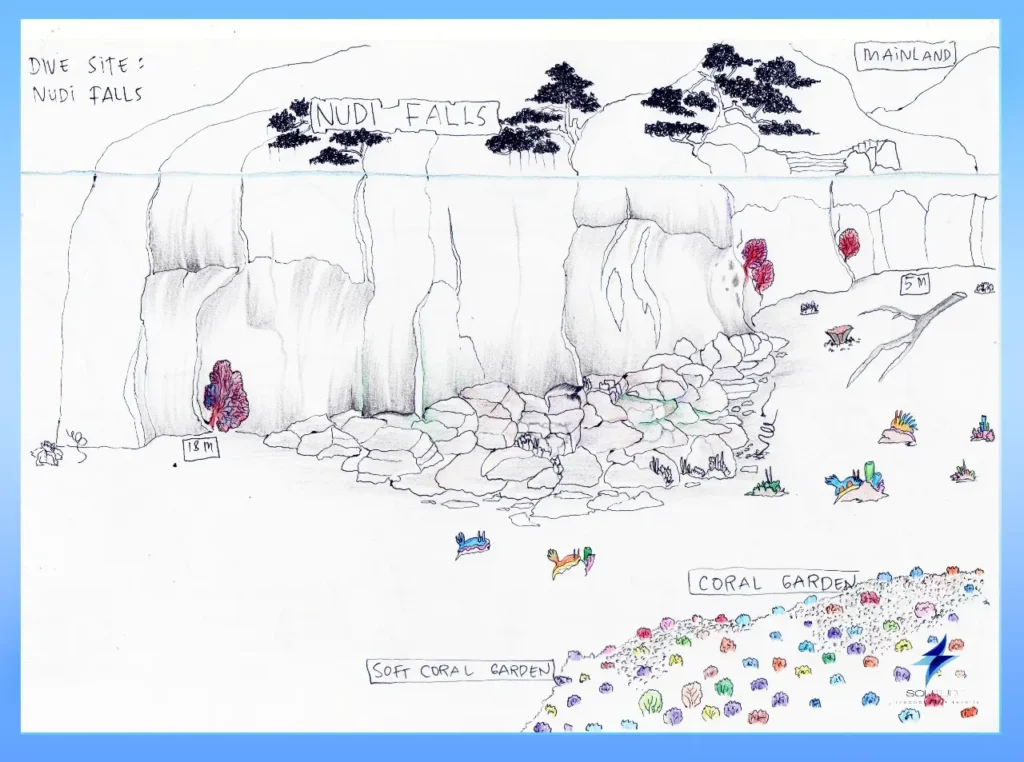
Just a quick four-minute boat ride from Solitude Lembeh, Nudi Falls is one of the most well-known and loved dive sites in the strait. The name comes from a time when nudibranchs would gather in such numbers that they seemed to “fall” from the wall with every diver’s bubble.
This site has a little bit of everything. A mini-wall drops to about 16 meters, then gives way to coral patches, soft sand, and a field of soft corals where candy crabs like to hide. It’s a great place to spot frogfish, pipefish, crustaceans, and, of course, nudibranchs in all shapes and colors.
With gentle conditions and plenty to explore, Nudi Falls is perfect for a relaxed, slow-paced dive. Whether it’s your first time in Lembeh or your fiftieth, this site always has something new waiting to be found.
2. Nudi Retreat
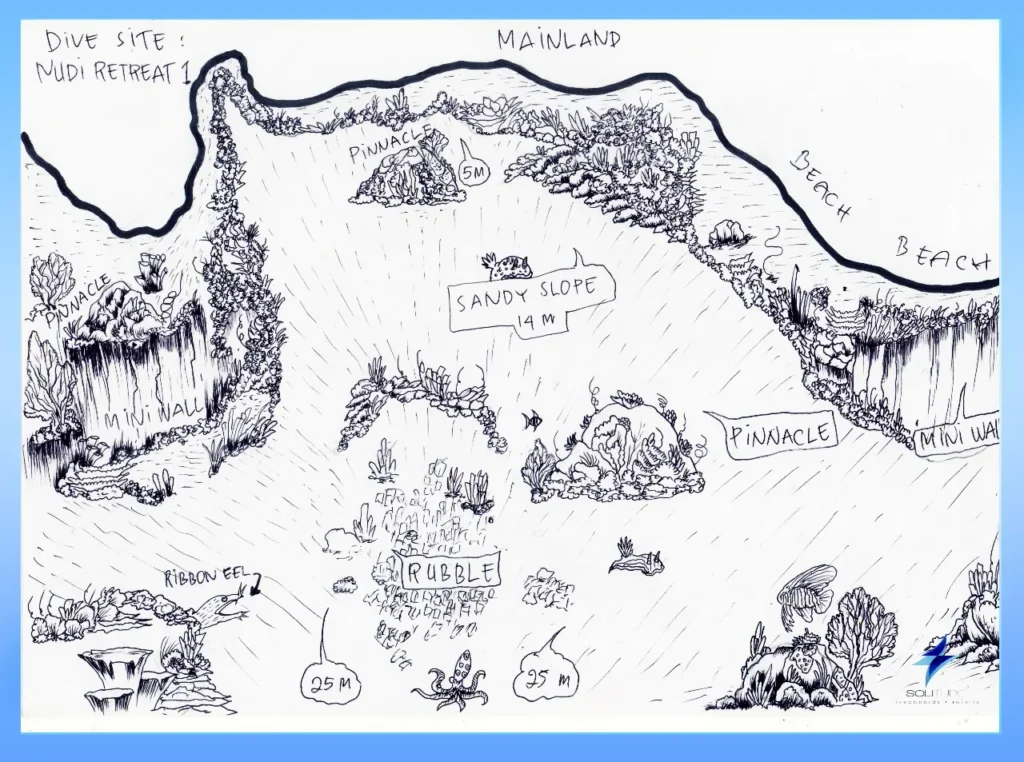
A five-minute boat ride north of Solitude Lembeh, Nudi Retreat offers a refreshing twist on the classic muck dive. Here, coral gardens meet sandy slopes, giving divers a rare mix of reef beauty and critter-rich terrain in a single dive.
This site is well known for its pygmy seahorses, including both red and yellow Bargibanti and the more elusive Denise’s variety, all clinging tightly to their sea fan homes. Tucked into a small wall, you might even spot the pulsing glow of an electric clam. Nudibranchs, reef fish, and other macro favorites are all part of the dive, with every turn revealing something new.
Nudi Retreat is perfect for those who love variety. Whether you’re searching for tiny seahorses or hoping for a lucky glimpse of a devil ray cruising in the distance, this site keeps the adventure alive from start to finish.
3. Angel’s Window
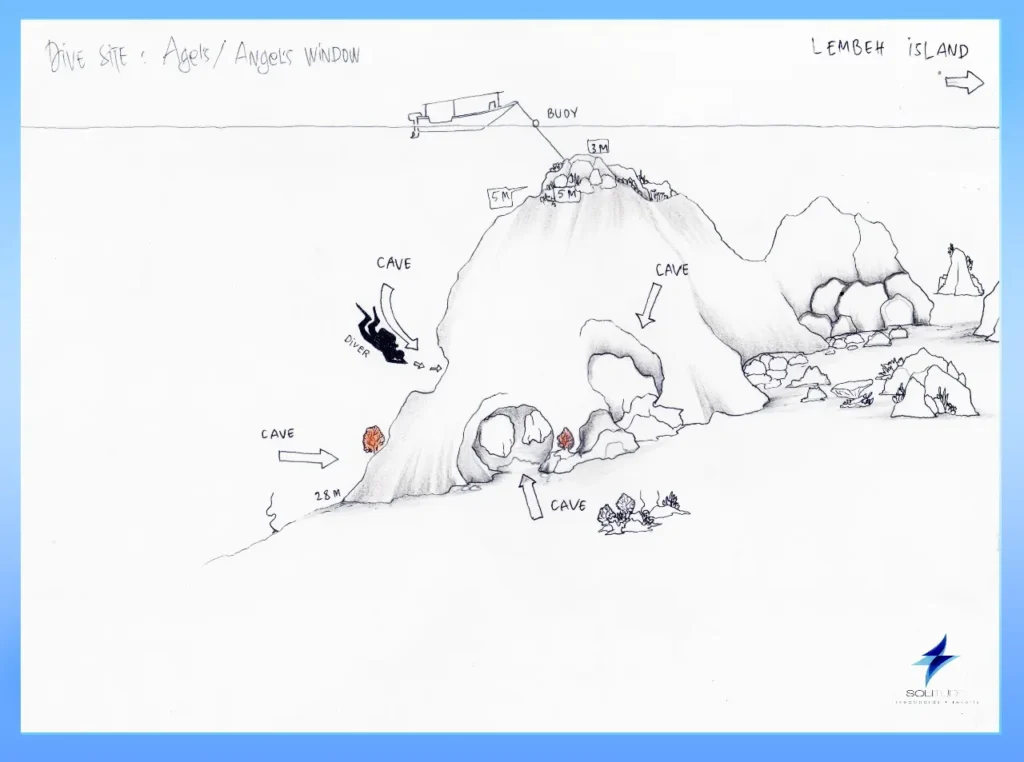
Angel’s Window is one of the Strait’s most unique and photogenic dive sites, and it’s only eight minutes from Solitude Lembeh by boat! Its name comes from a small swim-through cave that opens out into the blue, creating a natural window framed by coral and sunlight. It’s a favorite for wide-angle photography, especially when a diver drifts through the arch.
But there’s plenty here for macro lovers too. Inside the cave, a large sea fan hides the tiny Bargibanti pygmy seahorse, and the shallow areas often reveal the even smaller Pontohi seahorse. The coral formations across the site are lush and beautifully intact, offering a colorful backdrop and varied terrain.
Angel’s Window is a rare spot where you can chase both the wide and the small. It’s a dive that brings together Lembeh’s full range of underwater beauty in one memorable site.
4. Aer Bajo
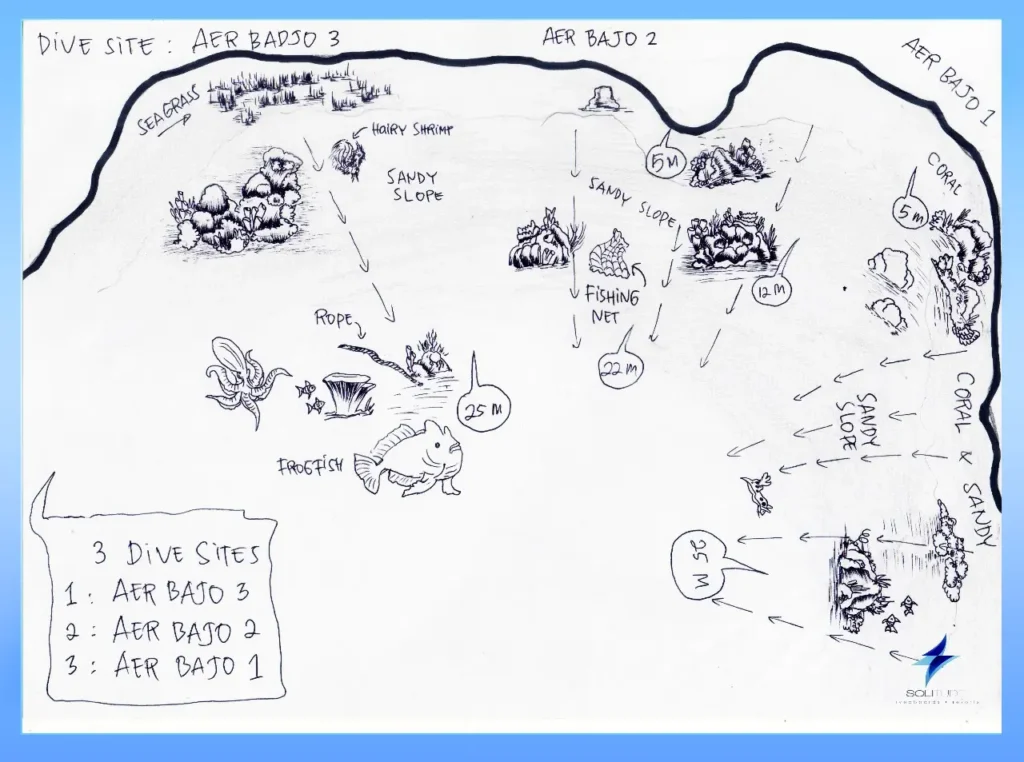
The Aer Bajo dive area is made up of three sites, each with its own twist on classic Lembeh muck diving. Aer Bajo 1 starts with a shallow coral reef around 5 meters before gently shifting into sand, making it great for both reef life and macro hunting.
Aer Bajo 2 features a sandy slope that runs down to about 22 meters, dotted with coral patches where critters love to hide. Aer Bajo 3 stands out the most, beginning with a seagrass bed that leads into a deeper sandy slope. This mix of habitats is perfect for spotting seahorses, pipefish, hairy shrimp, frogfish, and even octopuses in the shallows.
From reef to sand to seagrass, the Aer Bajo sites offer a little bit of everything and are full of surprises for patient divers with a curious eye.
5. Jahir
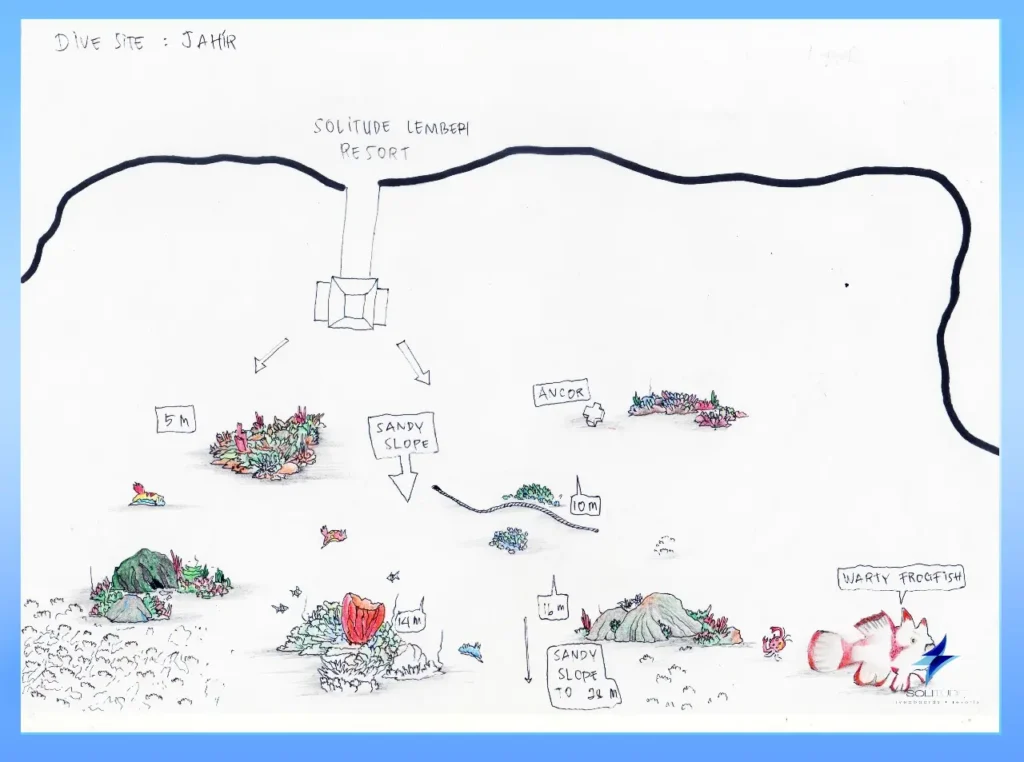
Jahir 1 delivers the classic Lembeh muck diving experience. Its dark sand and silty bottom are the perfect backdrop for some of the Strait’s most iconic macro encounters. This is a dive where patience pays off, and the search is part of the thrill.
Colorful nudibranchs crawl across the sand, frogfish blend perfectly into their surroundings, and the mimic octopus often steals the spotlight with its amazing shape-shifting tricks. Look closely and you’ll also find pipefish, shrimp, and other tiny critters hiding in plain sight.
With moderate depths and usually calm conditions, Jahir 1 invites long, slow dives that let you take it all in. It’s a must-visit for anyone wanting to experience the heart of Lembeh’s unique underwater world.
Marine Species and Critters You Can Encounter During Lembeh Diving
Diving in Lembeh Strait gives you the chance to see some of the most unusual and beautiful marine life in the ocean. This is one of the best places to find frogfish, flamboyant cuttlefish, pygmy seahorses, and blue-ringed octopuses, often all in the same trip.
If you love cephalopods, Lembeh is full of surprises. The mimic octopus and wunderpus are known for their strange movements and clever disguises. Along the sandy bottom, you’ll also find all kinds of tiny crustaceans. Harlequin shrimp, tiger shrimp, boxer crabs, and the small but fascinating hairy shrimp are often spotted here.
Nudibranchs are another highlight. With hundreds of species recorded in the area, every dive feels like a chance to discover something new.
To explore more of Lembeh’s marine life, check out our Lembeh Critters list!
What Equipment Do You Need for Lembeh Diving?
To get the most out of your Lembeh dives, especially if you’re into underwater photography, having the right gear makes all the difference.
- Camera System: DSLRs, mirrorless cameras, and compacts can all capture amazing shots in Lembeh, as long as they’re in a well-built housing suited for underwater use. Make sure your setup is fully sealed, rated for depth, and easy to handle underwater.
- Macro Lens: A lens in the 60mm to 105mm range is ideal for Lembeh’s macro stars. That focal length gives you the flexibility to shoot tiny nudibranchs up close or keep a bit of distance from shy subjects like frogfish and octopuses.
- Lighting: Lighting makes all the difference in muck diving. External strobes cut through particles and help restore the natural colors lost underwater. A constant focus light helps you compose shots more easily, especially in low-light situations like dusk or night dives.
- Dive Gear: A 3mm or 5mm wetsuit works well year-round in Lembeh, depending on your personal comfort and the season. Dives here tend to be long and slow, so staying warm is important.
Experience the Magic of Lembeh with Solitude

Diving in Lembeh Strait feels like entering a world filled with tiny, strange, and beautiful creatures. From well-known spots like Nudi Falls to quiet night dives and critter hunts in the seagrass, no two sites are the same, and every dive has something special.
At Solitude Lembeh Resort, we’re here to help you make the most of it. With PADI-certified private dive guides to assist you while underwater. After your dives, kick back in a comfy cabin and enjoy chef-prepared meals that hit the spot after a full day underwater.
If this kind of diving sounds like your thing, we’d love to show you around. Book your stay with us and explore the Critter Capital of the World!